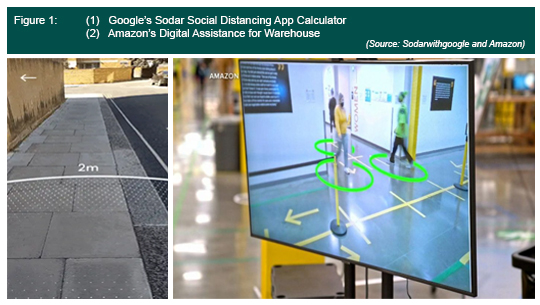3Q 2020 | IN-5860
Registered users can unlock up to five pieces of premium content each month.
Technology Companies Contribute to Maintaining Social Distancing after Lockdown |
NEWS |
One of the primary challenges for governments and businesses after the ease of lockdowns in many countries is to ensure health and safety while at the same time encouraging people to maintain the social distancing recommended as an effective method to slow down the spread of COVID-19. In order to contribute to this effort, technology leaders such as Amazon, Google, and Snapchat have developed solutions that encourage and assist the maintenance of safe social distance by leveraging Augmented Reality (AR), computer vision, and Artificial Intelligence (AI). These solutions can be applied in workplace environments and public areas in both indoor or outdoor locations (such as shopping malls and airports).
Amazon recently introduced a solution called Distance Assistance to help employees in warehouses keep a six-foot distance from their colleagues. The solution uses Machine Learning (ML) and AI to measure distance and distinguish employees from the surrounding environment, AR to deliver visual feedback (virtual green circles are displayed around employees who maintain essential distance and red circles are presented to employees who come too close), and a monitor that overlays real-time video. Regarding more consumer-focused solutions, Google launched a WebXR based application (only available for Android devices) called Sodar that, with the assistance of a device’s camera, will allow users to estimate a 2-meter distance. Furthermore, Snapchat launched an AR lens in collaboration with the World Health Organization (WHO) to raise awareness about the need for social distancing.
The major question is how valuable and practical are these solutions, and how can other AR solutions contribute to building social responsibility and safety?
 |
Limitations of AR Social Distancing Solutions |
IMPACT |
AR has proven to be a powerful communication/storytelling method that assists users in visualizing and better understanding concepts/products thanks to the 3D interactive and realistic digital elements that it lays over the real world. AR applications can contribute as a supplemental tool to educate, encourage, and remind users to seamlessly estimate and maintain 2 meters of distance. In addition, initiatives from social media players such as Snapchat or Instagram can significantly contribute to the effort against spreading the virus due to their large user bases and widespread influence in society. However, these type of AR applications, are limited by their mobile device-based requirement, which limits users’ movement flexibility and can put them at risk or be distracting. This means AR cannot effectively replace all physical signs/notifications, although there is the added element of real-time tracking and spatial accuracy that physical signage does not provide. Enterprise applications, where dedicated hardware can be leveraged, are more promising; however, Amazon’s Distance Assistance solution has limited practical value in its current form because the monitor that displays its feedback can be easily neglected by employees, especially during busy periods. A more robust implementation that could make the tracking actionable would solve this issue. Furthermore, the introduction of Distance Assistance and other wearable tracking solutions in the workplace raises privacy concerns regarding the continuous tracking of employees.
AR Applications Can Encourage and Enable Social Distancing |
RECOMMENDATIONS |
AR applications for product visualization and virtual try-on before purchase have already been adopted by many retailers, especially for e-commerce. Given the new requirements for social distancing and frequent sanitization, retailers can leverage AR solutions in-store (when applicable) to enable customers to explore and try-on products (such as accessories and cosmetics) virtually. In addition, QR codes that overlay digital content will also play an important role in reducing contact and associated risks. Businesses across various industries, including retail, hospitality, and tourism, can leverage QR codes in combination with AR to provide product information and/or guidance to customers and guests. Furthermore, the demand for AR remote expertise applications will remain high and help businesses/employees remain productive and avoid unnecessary travelling.
During the peak of COVID-19, AR smart glasses manufacturers such as ThirdEye, Rokid, and Vuzix included thermal scanning capabilities to detect fevers in travelers and employees. Compared to mobile devices, AR/Mixed Reality (MR) smart glasses help users maintain a safe social distance more efficiently, thanks to the instant feedback and notifications that are displayed in front of their field of view. However, given the current maturity level and adoption rate of AR smart glasses, this solution could only be applicable in certain businesses that have already adopted MR devices, and the number of employees who may have access to smart glasses is limited.
All in all, AR experiences taking many forms—AR filters on social media, utility or entertainment AR applications, dedicated machine vision and AR visualization hardware—can highlight and remind users of the importance and necessity of social distancing, in both workplace and public environments, while enabling some experiences and product opportunities not normally possible in the current global climate.